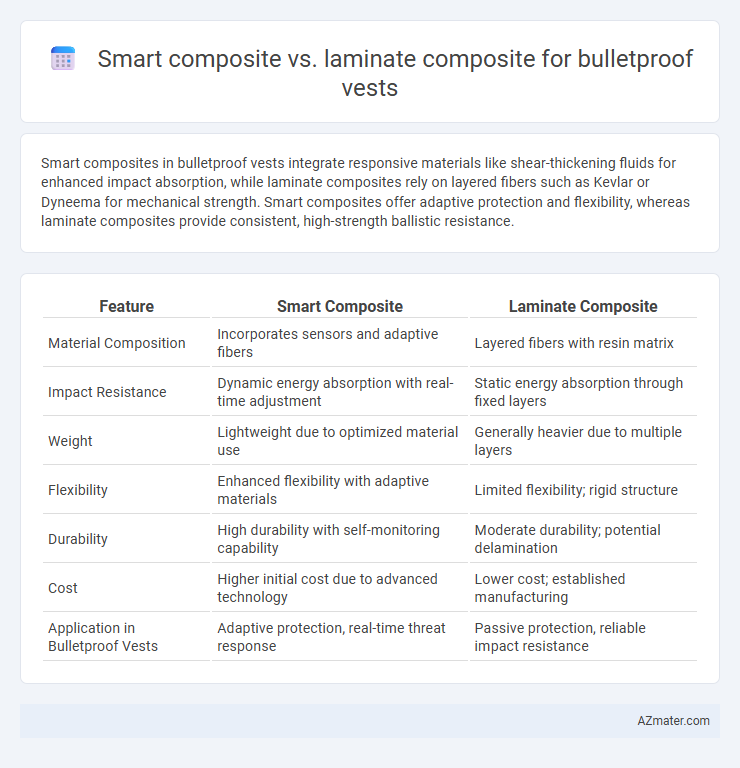Smart composites in bulletproof vests integrate responsive materials like shear-thickening fluids for enhanced impact absorption, while laminate composites rely on layered fibers such as Kevlar or Dyneema for mechanical strength. Smart composites offer adaptive protection and flexibility, whereas laminate composites provide consistent, high-strength ballistic resistance.
Table of Comparison
| Feature | Smart Composite | Laminate Composite |
|---|---|---|
| Material Composition | Incorporates sensors and adaptive fibers | Layered fibers with resin matrix |
| Impact Resistance | Dynamic energy absorption with real-time adjustment | Static energy absorption through fixed layers |
| Weight | Lightweight due to optimized material use | Generally heavier due to multiple layers |
| Flexibility | Enhanced flexibility with adaptive materials | Limited flexibility; rigid structure |
| Durability | High durability with self-monitoring capability | Moderate durability; potential delamination |
| Cost | Higher initial cost due to advanced technology | Lower cost; established manufacturing |
| Application in Bulletproof Vests | Adaptive protection, real-time threat response | Passive protection, reliable impact resistance |
Introduction to Bulletproof Vest Materials
Bulletproof vest materials primarily include smart composites and laminate composites, each offering distinct advantages in ballistic protection. Smart composites integrate advanced fibers like Kevlar or Dyneema with responsive materials that enhance energy absorption and flexibility upon impact. Laminate composites consist of multiple layers of woven fibers bonded together, delivering reliable ballistic resistance through layered structural integrity and increased durability.
Overview of Smart Composites
Smart composites integrate sensors and responsive materials that actively adapt to environmental changes, enhancing the protective performance of bulletproof vests. These composites offer real-time damage detection, impact absorption, and stiffness adjustment, improving wearer safety and comfort compared to traditional laminate composites. Incorporating nano-materials and embedded electronics, smart composites represent a significant advancement in adaptive ballistic protection technology.
Overview of Laminate Composites
Laminate composites in bulletproof vests consist of multiple layers of materials such as aramid fibers or ultra-high-molecular-weight polyethylene (UHMWPE) bonded together to enhance ballistic resistance through energy absorption and dispersion. These composites offer a balance of lightweight protection and flexibility, often outperforming traditional fiber-reinforced laminates in stopping high-velocity projectiles. Their multilayered structure allows customization in thickness and material combinations to meet specific threat levels and operational requirements.
Material Composition and Structure Comparison
Smart composites in bulletproof vests incorporate advanced materials like carbon nanotubes or graphene within a polymer matrix, offering enhanced impact resistance and flexibility compared to traditional laminate composites. Laminate composites typically consist of stacked layers of aramid fibers such as Kevlar bonded with resin, providing rigid multi-layer protection but limited adaptability to dynamic stress. The smart composite's integrated nanomaterials improve energy absorption and reduce weight, while laminate composites rely on thickness and layering for ballistic performance.
Ballistic Performance and Protection Levels
Smart composite bulletproof vests utilize advanced materials like shear-thickening fluids and nanomaterials to enhance energy absorption and improve ballistic performance compared to traditional laminate composites. Laminate composites typically consist of layered fibers such as Kevlar, which provide proven multi-hit resistance but may be heavier and less flexible. Smart composites often achieve higher protection levels at reduced weight, offering superior comfort and maneuverability without compromising durability against high-velocity ballistic threats.
Flexibility and Comfort for Wearers
Smart composites in bulletproof vests offer superior flexibility and comfort compared to traditional laminate composites by integrating advanced materials like shear-thickening fluids or nano-fibers that adapt to wearer movements. Laminate composites, typically made of rigid layers such as Kevlar or ceramic plates, provide robust protection but often sacrifice mobility and breathability, leading to increased wearer fatigue. Enhanced flexibility in smart composites reduces stress points and improves wearer endurance, making them more suitable for extended use in dynamic environments.
Weight and Thickness Considerations
Smart composites for bulletproof vests typically offer reduced weight and thickness compared to traditional laminate composites, enhancing wearer mobility and comfort. Advanced materials like nano-engineered fibers and shear-thickening fluids in smart composites allow for superior ballistic protection with less bulk. Laminate composites generally rely on stacking multiple fabric layers, resulting in heavier and thicker vests that may limit agility.
Durability and Environmental Resistance
Smart composites for bulletproof vests exhibit superior durability due to their adaptive fiber structures and embedded sensors that monitor stress and wear in real-time. Laminate composites provide high initial resistance but may suffer from delamination and reduced integrity under prolonged environmental exposure such as moisture and UV radiation. Smart composites offer enhanced environmental resistance by maintaining structural stability and performance in varied conditions, making them more reliable for long-term protective applications.
Cost and Manufacturing Differences
Smart composites for bulletproof vests incorporate embedded sensors and adaptive materials, increasing production complexity and cost due to advanced technology integration. Laminate composites utilize multiple layers of woven fibers like Kevlar or Dyneema bonded with resins, offering a more established, cost-effective manufacturing process with simpler scalability. The higher material and labor expenses of smart composites contrast with the comparatively lower-cost, traditional lamination methods used in laminate composites.
Future Trends in Bulletproof Vest Technologies
Smart composites in bulletproof vests incorporate sensors and adaptive materials that enhance impact resistance and provide real-time health monitoring, pushing the boundaries of protective gear technology. Laminate composites, traditionally made from layers of materials like Kevlar and UHMWPE, offer proven ballistic protection but lack the dynamic response capabilities of smart composites. Future trends indicate a shift towards integrating nanomaterials, self-healing polymers, and IoT connectivity in smart composites to create lighter, stronger, and more intelligent bulletproof vests.

Infographic: Smart composite vs Laminate composite for Bulletproof vest
 azmater.com
azmater.com